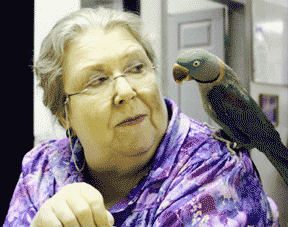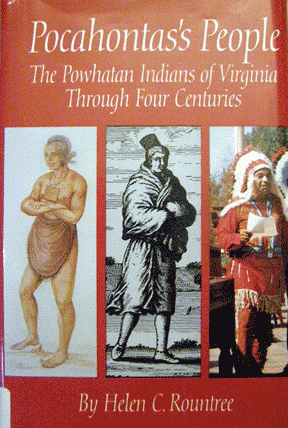On the Job
with Author and Anthropologist Helen Clark Rountree
Hunting and Gathering Clues to Piece Together the History of Chesapeake Bay Indians
by Dotty Holcomb Doherty
“I’d rather research than eat,” says Helen Rountree, who has returned from the summer of John Smith to her Hampton, Virginia, home to research and write. Her seventh book — John Smith’s Chesapeake Voyages, 1607-1609, co-authored with Wayne E. Clark and Kent Mountford — made her a frequent visitor to Maryland.
As in her all her books — Rountree’s stories of 17th century Indians capture modern imaginations. She tells of strong, capable women who spent their days pulling tubers from two feet of marsh mud, tending fields to feed their families and tribes, paddling canoe-loads of reeds and collecting firewood, often far from home. Of lean hunters and fishermen derided by the newly arrived English for laziness because they did not farm. Of toddlers who won their breakfast by shooting down, with bow and arrow, a chunk of moss tossed by mothers teaching them life skills.
A hunter and gatherer in her own right, Rountree has dedicated 40 years searching for clues to piece together the cultural history of Chesapeake Bay Indians. Her specialty is the Algonquian-speaking Indians of Virginia, known collectively as the Powhatan, the people who met the English when they arrived in Jamestown 400 years ago and whose ancestors thrive today.
The term Indian — a misnomer since Columbus — is generally accepted by both Virginian and North Carolinian tribes.
Rountree, 63, follows her quest wherever it leads, even into marsh mud. When 17th century writings helped her identify the often-mentioned Indian tuckahoe as the freshwater plant arrow arum, she mucked into the marshes to dig it herself.
“Tastes like a bee sting,” she says, if eaten before the necessary leeching and drying to remove the acids. “I tried it in the name of science and suffered accordingly.”
Which adds a nice irony to her dietary preference for research.
Time Traveling
Rountree hunts and gathers in lost time. The early Powhatans had no written language, so the closest she can get is the writing of early explorers. Besides John Smith, a favorite early writer is William Strachey (1572-1621), an English colonial historian who visited Virginia in the early 1600s.
Court records added more clues. During three decades as an anthropology professor at Old Dominion University, Rountree spent summers tucked into courthouses, speed-reading centuries of documents for mentions of Indians. One surprise: Indians had the rights of citizens under Virginia law.
“Under the treaty of 1677 and informally before then,” Rountree says, “Indians in Virginia, unlike Maryland, were treated like citizens with the same civil rights as the English until the end of the 17th century.”
Land records and civil records — in the counties not burned during the Civil War — add more information. Unless, Rountree says, “you were poor or law-abiding. Then you were invisible.”
She’s discovered people saved from annihilation by European diseases because of their seasonal movements from farming villages to hunting camps. Governments organized by chiefs, both male and female, priests and council meetings, where manners forbade interrupting a speaker. Of times of peace, trade and prosperity, alternating with wars with non-Algonquian speakers: the Algonquian Powhatans against the Siouan Monacans and Mannahoacs; the Algonquian Piscataways and Patuxents against the Iroquoian Massawomecks. The arriving English complicated native politics, and some tribes united against this new enemy.
Rountree calls her greatest achievement connecting the modern Powhatan people back 400 years to colonial days. No one had ever done it. No one thought it was possible. She documented their continuity in her favorite of her seven books: Pocahontas’s People: The Powhatan Indians of Virginia through Four Centuries.
“Most books on eastern Indians start in the 17th century and jump to the 20th,” Rountree says. “Mine didn’t because I found records from the 18th and 19th centuries.”
The only other anthropologist who has succeeded in making this four century connection is John Strong with the Montaukett Indians on Long Island. His inspiration, he says, was Rountree.
Rountree found that the Powhatans maintained their traditional culture throughout the 1700s and early 1800s, despite attempts by the English to civilize them. Much of their land along the rivers was occupied, and genocide had reduced them from 14,000 during the early 1600s to 600. Yet the men continued to hunt — now more likely with guns than bows — and the women farmed. Skins, baskets and pots became trade items for European goods: guns, ammunition, cloth and iron tools. They kept their religious beliefs and practices, usually hiding them from the English.
Continuity as a unique culture was even more difficult after the Civil War. As white Virginians sought distinction from all coloreds, segregating schools and churches, Indians were lumped in with blacks, further blurring their identity.
As a hunter-gatherer, Rountree had to dig deep, but she found core groups of Indians who refused to disappear.
The Star Trek Directive
Yet discovering the historic Powhatans proved easier than getting along with the modern Powhatans.
Yes, they do exist.
“If you no longer speak the tribal language, if you don’t wear feathers all the time, if you don’t go to work on horseback and if you don’t look like Sitting Bull, certain insensitive types claim you are not a real Indian,” says Rountree. All eastern tribes are separated from their identity by this credibility gap — among citizens, government and, as Rountree has discovered, even some anthropologists.
The Indians exist, but they keep their own counsel. And they are hesitant to welcome anthropologists.
Rountree’s Nordic looks — blonde hair, pale skin and blue eyes — resembled those of the Indians’ oppressors. Anthropologists are at the mercy of their appearance, Rountree explains. If the people being studied have been insulted or harmed by someone who looks like the researcher, prejudice is likely.
In the 1960s, when Rountree first began visiting the local tribes, she was too blonde, too young and too female.
“The old timers would shy off from my looks,” she says. “They felt I was too young to know anything. And as I was female, the men assumed I couldn’t possibly know anything about politics, much less about hunting, which they loved.”
Too many of the tribal elders remembered the days of Virginia’s 1924 Racial Integrity Law, which put all citizens into two categories — white or colored — eliminating the designation Indian on birth records. Until 1948, Virginia Indians were not allowed to vote. To study in high school, they had to leave the state. The past still rankles.
Education also got in Rountree’s way. Many of the Indians she sought to question were from generations denied high school educations. They felt threatened by Rountree, whose education made her Doctor Rountree.
Despite these obstacles, Rountree persevered. Chiefs — the eastern tribal council leaders — accepted her polite inquiries, trusting her with bits of information. Eventually, she even made friends. Rountree’s research has made her an authority on the historic Powhatans, but not of the modern people. They, she says, are the experts of themselves.
“I came up with the Star Trek Directive before Star Trek was invented,” says Rountree. “Don’t mess with the natives.”
Movie Madness
Or romanticize them in movies.
“I don’t work with movie people,” Rountree says. “They live on a different planet than me.” She shared one lunch in 1992 with a Disney producer seeking her help on the animated Pocahontas. She gave up one name. After the movie’s 1995 debut she was so appalled by its inconsistencies that she wrote a children’s book, Young Pocahontas in the Indian World, to rebut it.
“And I had nothing whatever to do, by my own volition, with the Terrence Malick movie, The New World,” she says. “It tanked, and I am so glad it did. I still have to hear about the Pocahontas cartoon, but I hardly hear anything now about The New World.”
The Way of the Hunter-Gatherer
Rountree always has a book underway, and several more in mind.
Book eight will cover the Indians of Southern Maryland. This collaboration with anthropologist Rebecca Seib will place the last piece in the Chesapeake puzzle.
“Once this book comes out,” Rountree says, “there will be books about all the Algonquian speakers in the Chesapeake region.”
Book nine is still in the talking stage. Rountree has learned of a botanist in Delaware with an interest in Indians. Together, they hope to compile a book that looks not only at how the Indians used native plants, but how people can grow them in their gardens today.
“I have been driven,” Rountree says. Everything, even meals, is secondary to research and book-writing. “People who are like that,” she adds, “should not have spouses and children. I am a spinster.”
